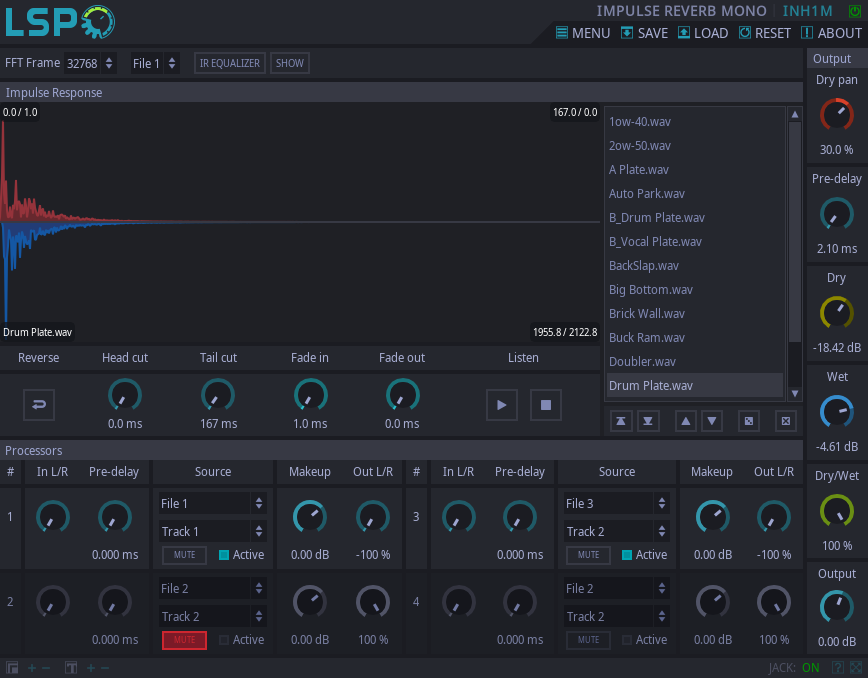Impulse Reverb Mono

Detailed: LSP Impulse Reverb Mono (INH1M)
Formats: CLAP, JACK, LV2, VST2, VST3
Categories: Reverb
Developer: Vladimir Sadovnikov
Description:
This plugin performs highly optimized real time zero-latency convolution to the input signal. It can be used as a cabinet emulator, some sort of equalizer or as a reverb simulation plugin. All what is needed is audio file(s) with impulse response taken from the linear system (cabinet, equalizer or hall/room).
Unlike the Impulsantworten (Impulse Responses) plugin series, up to four input files and convolution processors can be used to implement and mix different kinds of reverberations.
Controls:
- Bypass - bypass switch, when turned on (led indicator is shining), the plugin bypasses signal (but still performs processing).
'Impulse response' section:
- File - file editor selector
- FFT frame - the maximum size of the FFT (Fast Fourier Transform) frame that can be used for time-continuous convolution
- IR equalizer - shows wet signal equalization overlay.
- Show - Displays the additional Wet Signal Equalization section in the UI
- Reverse - allows to reverse impulse file in time domain.
- Head cut - cut amount of milliseconds from the beginning of the impulse files, can be used to remove early reflections of reverb.
- Tail cut - cut amount of milliseconds from the end of the impulse files, can be used to remove large reverberation tail.
- Fade in - adds additional fading at the beginning of the impulse file.
- Fade out - adds additional fading at the end of the impulse file.
- Listen - this button allows to listen preview of the audio file.
- Stop - this button allows to stop preview of the audio file.
'Processors' section:
- Pre-delay - amount of pre-delay added to the processed signal. Can be used to individually control pre-delay of processed signal for each processor that can provide additional stereo effect for reverbs.
- Source - combos allow to select file and track to use as the convolution for the processor.
- Mute - button allows to disable the processor.
- Active - led that indicates that the processor is active.
- Makeup - amount of gain added to the processed signal for the processor.
- Out L/R - the output balance of the processed signal between two channels in the stereo pair.
'Output' section:
- Dry Pan L/R - the panning of the dry (unprocessed) signal.
- Pre-delay - amount of pre-delay added to the wet (processed) signal.
- Dry - amount of gain applied to the dry (unprocessed) signal.
- Wet - amount of gain additionally applied to the wet (processed) signal.
- Dry/Wet - the balance between the unprocessed (Dry) signal and mixed signal (see Dry and Wet controls).
- Output - amount of gain additionally applied to the output signal.
Wet Signal Equalization overlay:
- Enabled - enables wet (processed) signal equalization.
- Low-cut - sets the slope of the high-pass butterworth filter, possible slopes are 6, 12 and 18 dB/octave.
- Low-cut freq - the cutoff frequency of the high-pass butterworth filter.
- Faders - faders that allow to change the loudness of eight corresponding frequency bands in range of -12..+12 dB
- High-cut - sets the slope of the low-pass butterworth filter, possible slopes are 6, 12 and 18 dB/octave.
- High-cut freq - the cutoff frequency of the low-pass butterworth filter.































